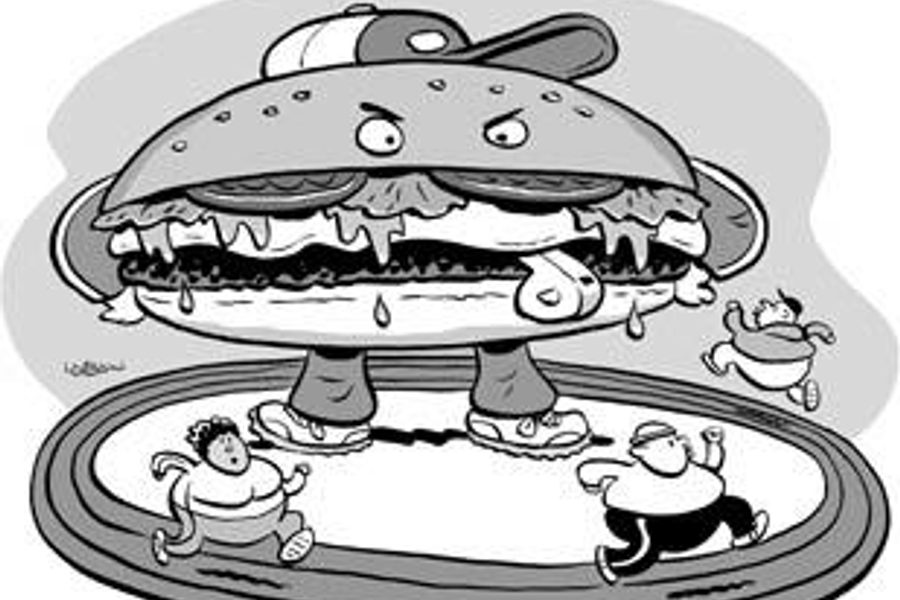
Like her friends from Mexico to Chile, the girl from Ipanema is getting too big for her britches.
Latin America has fallen prey to the “globesity” trend, adding to the ranks of the one billion people the World Health Organization (WHO) says are overweight around the world. Globalization, with its accompanying sedentary lifestyles and proliferation of fast-food conglomerates, is a major culprit. As a 2001 study by Ricardo Uauy, a researcher at the University of Chile’s Institute of Nutrition and Food Technology, noted, “as income increases in transitional countries, so does the consumption of high fat foods, including industrially processed hydrogenated fats.” Globesity’s spread is bad news for struggling countries with stressed health systems that will have to tend to fat’s future fallout, from diabetes to heart problems.
Policymakers’ responses have been mixed, from introducing legislation to criticizing global corporations to denying the problem altogether.
Mexico has adopted national legislation to fight the problem. In figure-obsessed Argentina, where 30 percent of the population is estimated to be dieting on any given day, an obesity law is awaiting a Senate vote. But fat’s real Latin American enemy appears be Chile.
With strong trade ties to the United States, Chile has logged South America’s most sustained growth in recent years. And it’s not just mirroring Washington’s preference for trade liberalization, open markets and tax policy, but Americans’ expanding figure as well: The Center for Family and Community Health at UC Berkeley predicts that 9 million Chileans will be obese by 2010.
Politicians like Chilean Congressman Fulvio Rossi are lashing back at bulge. In tandem with a decade-long anti-obesity program started in 2000 by the Chilean government, he has proposed a junk food tax and measures to give school kids more time for physical activity. He is also targeting la comida chatarra, or junk food. In a February 8 interview with a leading Chilean newspaper, Rossi lashed out at McDonald’s new nutritional guidelines.
“Unfortunately, McDonald’s is engaging in false advertising,” Rossi said. “They are saying in their nutritional information that the caloric requirements of minors are larger than what they really are to justify the consumption of hamburgers.”
The Brazilian Institute of Geography and Statistics also caused a stir last year by reporting that just over 40 percent of adult Brazilians are overweight, and that one in 10 adults is obese. Against a backdrop of globalization this news may not be all that surprising: Carlos Augusto Monteiro, a nutritionist at the University of São Paulo, has reported that soft drink consumption in that country has shot up 400 percent in the last 30 years. Demographic shifts mean more sedentary lifestyles for more Brazilians; between 1940 and 2000, the country’s population, now 175 million, went from being 80 percent rural and 20 percent urban to 80 percent urban and 20 percent rural.
So what is the corrective?
Laws mandating public education are designed to teach the newly globalized how to eat well and resist sedentary ways. But obesity can be a complicated political football. Last January, for example, Brazil’s President Lula da Silva dismissed obesity figures because he draws political clout from a public battle against poverty and food insecurity. According to a New York Times article, da Silva claimed that the study was likely skewed because the subjects did not report accurately. “Hunger isn’t something to be measured by research,” da Silva said. “Not everyone wants to recognize that they are going hungry. They are ashamed.”
Another worrisome trend is that policy types in Latin America, just like their counterparts in the United States, may be relying too much on information generated by the very industries causing the obesity problem.
That issue came sharply into focus in early February when the Associated Press and other outlets reported that the WHO had blocked an influential, corporate-backed science group from participating in setting food and water quality standards.
The International Life Sciences Institute (ILSI) is a rising player in some of Latin America’s obesity battles. In Brazil, Chile and Mexico, ILSI is launching the Healthy Lifestyles, Healthy People (HLHP) project, a campaign to fund scientists trying to tackle the problem. The group is working with the Pan American Health Organization, the WHO and the U.S. Centers for Disease Control and Prevention. ILSI says the goal is to build “sound obesity prevention” in Latin America by 2007 through encouraging good diets and exercise.
The problem, say critics, is that ILSI represents the kings of chatarra, with a roster of corporate associates including Coca-Cola, General Mills, Hershey Foods, Kellogg, Kraft, McDonald’s, Nestle and PepsiCo.
Such links are the target of ILSI critics. In December, the Washington-based Natural Resources Defense Council, along with more than a dozen other U.S.-based NGOs, cited ILSI’s financial conflicts of interest as a reason for the WHO to break its ties with the group. As ILSI gears up to fight obesity in Latin America, they say that the institute has been wielding undue influence over the WHO by presenting suspect scientific data on topics from tobacco to water quality issues – data that is eventually used to calibrate health standards.
ILSI’s detractors point to an illustrative case: In 1998, ILSI co-funded a WHO-UN Food and Agricultural Organization (FAO) report on nutrition and carbohydrates. The ILSI-backed study concluded that there was no direct link between sugar consumption and obesity, and advised there be no upper limit set for amounts of sugar in the diet.
Limiting ILSI’s influence “is an extremely important decision by the World Health Organization,” says Jennifer Sass, of the National Resource Defense Council. “We hope that this new decision will prevent direct collaborations between ILSI and WHO that shut out other perspectives and participants.”
The victory is a mixed one: The WHO’s February statement still recognized ILSI as a working partner in good standing but specified that it can play no role in standards setting. Suzanne Harris, ILSI’s executive director, says she doesn’t understand why the decision has gotten attention because it has changed nothing.
“ILSI has not been involved in standard-setting exercises recently, and perhaps never,” Harris says. She added that in the case of the sugar report, the institute “was charged with reviewing the available data and making recommendations” to groups who could set standards, but she stressed that “ILSI was not involved in that activity.”
“The WHO has a long history with ILSI manipulations and maneuverings, some of which I witnessed,” says Marion Nestle, a professor at New York University and author of Food Politics. “It is understandably impatient with an organization that pretends to be independent, but is owned and operated by food companies.”
Kathryn L. Mulvey, executive director of Corporate Accountability International, a U.S.-based nonprofit group, plans to keep the pressure on. “Vigilance by governments and NGOs will be required to enforce ILSI’s new exclusion from collaboration with WHO on normative and standards work,” she says.






